1 Introduction to Human Diversity and Leadership: Terminology & Guiding Frameworks
Grounding
Choose some ritual(s) that will bring your mind/body into focus as you take in the following chapter. For some, this might be a few deep breaths; for others, a prayer or mantra might be preferred; for still others, a cup of tea, or a comfy reading nook might do the trick. Considering what has worked well for you in the past and what you are noticing you need in this present moment, try to set yourself up to engage the material with openness, thoughtfulness, and integrity. When you are situated as well as possible for your current conditions, consider the following questions:
- Think of an artist, celebrity, political figure, or a person you know who you consider to be a good leader to a variety of people. Name some of the characteristics or practices this person has that help them in their leadership role(s).
- Name the leadership roles you have held or are currently holding. Note: Think of leadership in various settings(school, work, faith communities, family, friend groups, social organizations, and beyond).
- What is your current understanding of the term diversity? How does it differ from equity and inclusion?
When I was a child, I often heard the phrase, “That’s just common sense” but the things that were considered common knowledge always seemed to be moving targets. Albert Einstein is credited with saying that “common sense is the collection of prejudices acquired by age 18.” Which of the following common-sensisms have you heard (or believed) to be unequivocal truths?
- You should always be a little early.
- You should always be a few minutes late.
- You should always say, ma’am and sir.
- You should never say, ma’am and sir.
- Your body is dangerous and evil.
- Your body is safe and sacred.
- True Christians are conservative.
- True Christians are progressive.
- Prioritizing diversity makes life better for everyone.
- Prioritizing diversity is a form of discrimination.
If one (or more) of the above feels especially true to you, take a minute and try to find at least one exception to the rule. Good leaders must be committed to critical thinking, which is to say interrogating the statements, policies, and presumptions that others may accept without question or concern. The mission of social work requires that we prioritize the well-being of those who are vulnerable, oppressed, and living in poverty (NASW, 2021). In this text we we will examine a variety of ways to do so, but first, we must get situated in what is meant when using words like diversity, equity, inclusion, and even justice.
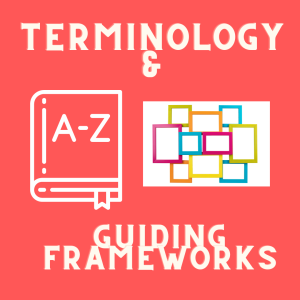 Grounding Terminology
Grounding Terminology
There are many ways of discussing how systems impact people with various identities and also how people with various identities impact the systems in which they are situated. You may have seen acronyms including DEI (Diversity, Equity, and Inclusion), DEIB (Diversity, Equity, Inclusion, and Belonging), JEDI (Justice, Equity, Diversity, and Inclusion), ADEI (Anti-Racism, Diversity, Equity, and Inclusion), EDI (Equity, Diversity, and Inclusion) and others as more pop up each day. This is evidence of how many individuals, groups, and organizations are attempting to capture the complex and important work of examining different identities and disproportionate outcomes across a wide range of institutions/systems. This text will mostly use the acronym DEI as defined in its separate terms below, along with the working definitions of leadership and justice.
Diversity is the presence of various intersectional identities in a given space. It might answer the question, “Who is in the room?” or “Who is at the decision-making table?”.
Equity is the presence of policies, practices, processes, and opportunities that make it similarly possible for individuals with a variety of intersectional identities to participate in a certain space. It might answer the question, “How easy was it for them to enter this room?” or “How easy was it for them to find/get a place at the decision-making table?”
Inclusion is the presence of power and participation given to various intersectional voices in a given space. It might answer the question “Whose stories/ideas/decor/dress/speed/volume/food/ways of being are considered acceptable and desirable in this room or at the decision-making table?”
(Questions above are adapted from Archway Programs)
Justice has a range of definitions from the narrow end of the continuum to the broad end. The National Association of Social Work defines Social justice as “the view that everyone deserves equal economic, political, and social rights and opportunities” (NASW, 2022).
A popular depiction of some of these terms created by @restoringracial justice is below:
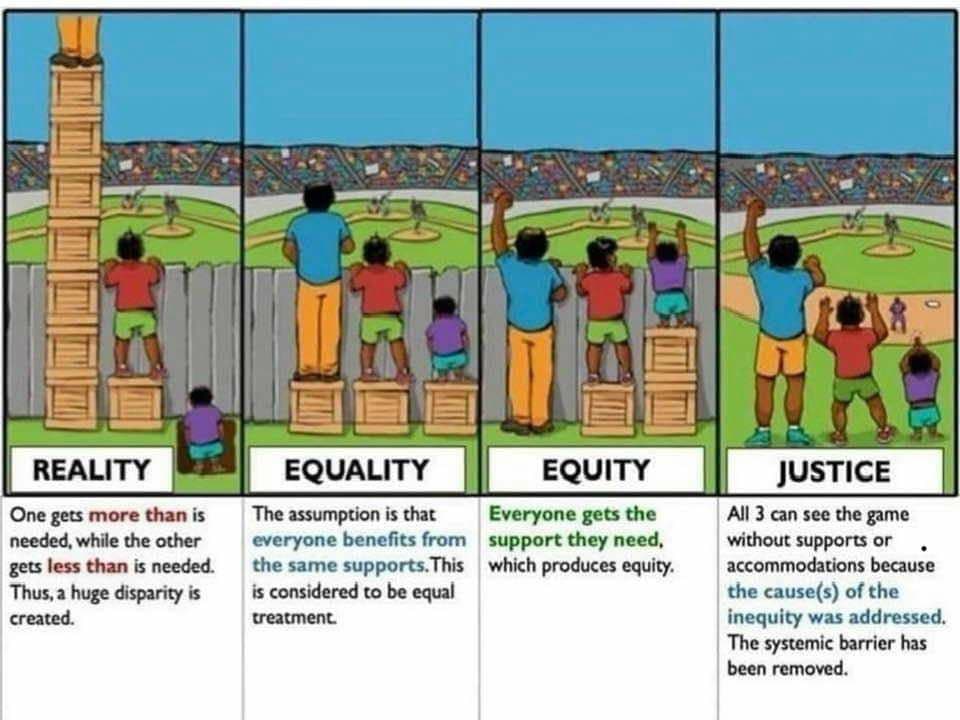
Notice that equality and equity are not synonymous. If everyone who reads this text is gifted a pair of reading glasses because the author indicates a desire to be inclusive and remove any barriers to reading ability, an equality approach might be to send everyone the same pair of glasses with the same prescription as the author’s. However, this wouldn’t actually level the playing field, would it? In fact, it might actually disadvantage some readers to use a prescription that would cause their eyes further strain, while advantaging people who happen to have the same prescription as the author.
An equity approach, on the other hand, might be surveying each potential reader about the barriers and needs associated with reading this text. It could be that this results in purchasing and sending glasses to everyone with the appropriate prescriptions, or, the author could discover that the more pressing need for reading accessibility is actually better internet access or assistive technologies. For justice to be achieved systemic shifts would be so comprehensive that all materials would be designed with every type of reader in mind such that no special surveying/assistance is needed. This is an ambitious but important goal for any of us in leadership/power positions.
Leadership: The concept of leadership has often been built on dominant ideological notions of who and how authority should look, feel, sound, and behave. The Center for Creative Leadership has created the “fundamental 4” core leadership skills needed to engage in more accessible, flexible approaches as leaders. The fundamental four are pictured below.
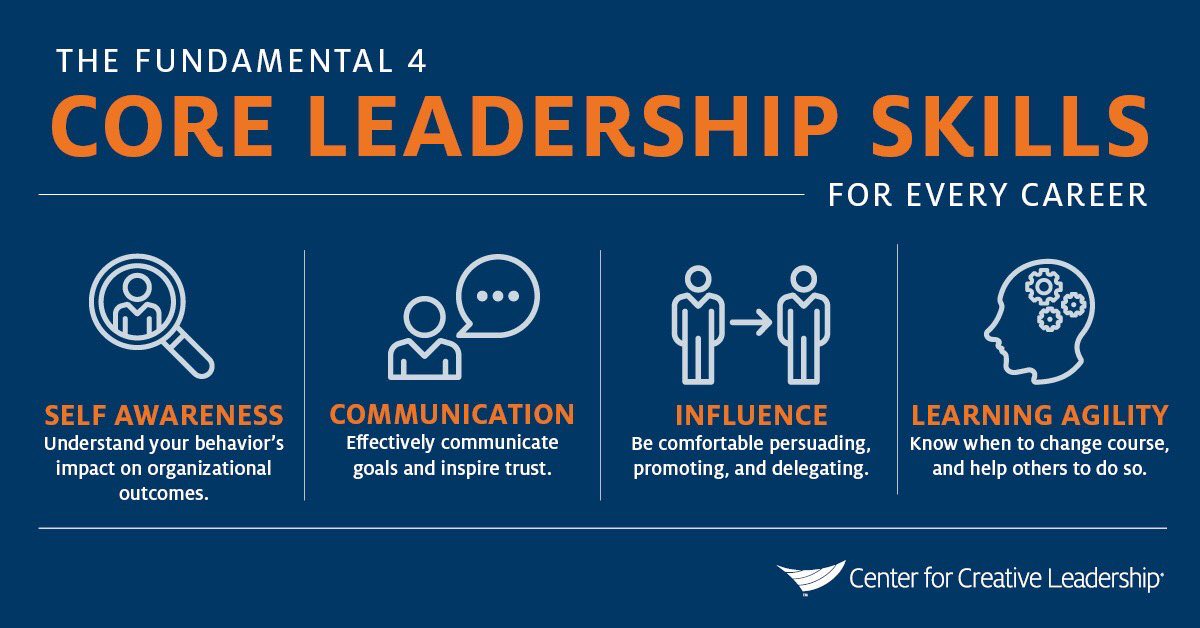
Guiding Frameworks
Five models/frameworks will guide the rest of this text. They include the Tripartite Model of Personal Identity, Counterintuitive Solidarity, Cultural Humility, and Intersectionality. See definitions for these terms below.
- Tripartite Model of Personal Identity: The first guiding framework comes from Doctors Derald Wing Sue, Mikal Rasheed, and Janice Rasheed who have developed a model birthed from an (unspecified) Asian axiom that all people are in some regards “like all other people”, “like no other people”, and “like some other people” (Sue, Rasheed, & Rasheed, 2015)).. The visual depiction below further illustrates the ways that all of us are defined as unique individuals, as members of broader group identities, and by virtue of universal human experiences.
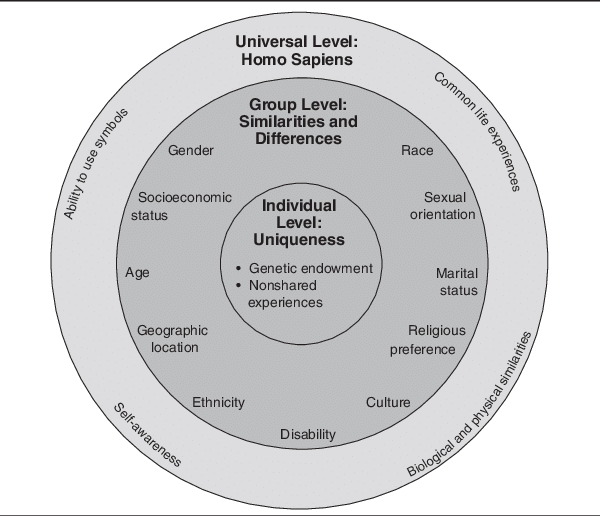
-
- Example: Paola and Sophia are identical twin sisters, however, due to unequal placental sharing in utero Paola received fewer nutrients than her twin and was subsequently born at a birth weight that required immediate and ongoing medical supervision and intervention apart from the family, while Sophia was able to stay with their parents for the first week of her life. Even two humans that share DNA immediately find themselves with different access to resources based on their situatedness in their external environments (Individual). Both girls are Mexican American and will be shaped by shared food, rituals, and religious experiences throughout their lives. This shaping will be different than if they had been born into a different ethnic identity (Group). Throughout all of their shaping, each woman will experience grief over limitations and losses because limitations and loss are fundamental aspects of the human condition (Universal).
- Counterintuitive Solidarity: to trust the intuition of oppressed people over and against one’s own gut and experience, which is proven to lead you astray when operating from a vantage point of dominance. Privileged people must do something very absurd and unnatural; they must move decisively towards [counterintuitive solidarity with] those on the margins [while] allowing the eyes of the violated to lead and guide the way (Hart, 2016).
- Example: John Robert is a fifty-year-old man who has recently learned that his 20-year-old daughter Evie is bisexual and that people often discount her sexual identity as a phase or “attempt to get attention”. There was a time in J.R.’s life when he believed that bisexuality was a myth but after reading, watching, and listening to many stories of queer individuals, he understood that 1.) when someone shares the truth about their sexual identity it is important to assume that they are the expert of their own bodies, 2.) that they might feel scared to share for fear of judgment/loss and 3.) that it is best not to suggest that someone who is bisexual just forget or abandon their attraction for individuals of the same sex and/or gender. Because John Robert trusted the voices of queer people in his life and in the content he consumed, he was able to tell his daughter that he loved her, accepted her, and appreciated her vulnerability to share something so personal with him.
- Cultural Humility: a lifelong process of critical self-reflection whereby an individual not only learns about another’s culture but rather starts with an examination of their own beliefs and cultural identities. Additionally, cultural humility requires mitigating power imbalances and ensuring institutional accountability. Watch the story of the development of this term here (Tervalon & Murray-Garcia,1998).
Students often want to know, how to establish the practice of cultural humility in everyday existence. The 7E model gives a set of overlapping multi-directional experiences that encourage lifelong critical self-reflection, as well as opportunities for challenging power differentials in communities and holding institutions accountable for their actions (and inaction). The following image and description of the model are excerpted from An Experiential Model for Cultivating Cultural Humility and Embodying Antiracist Action In and Outside the Social Work Classroom (Fisher, 2021).
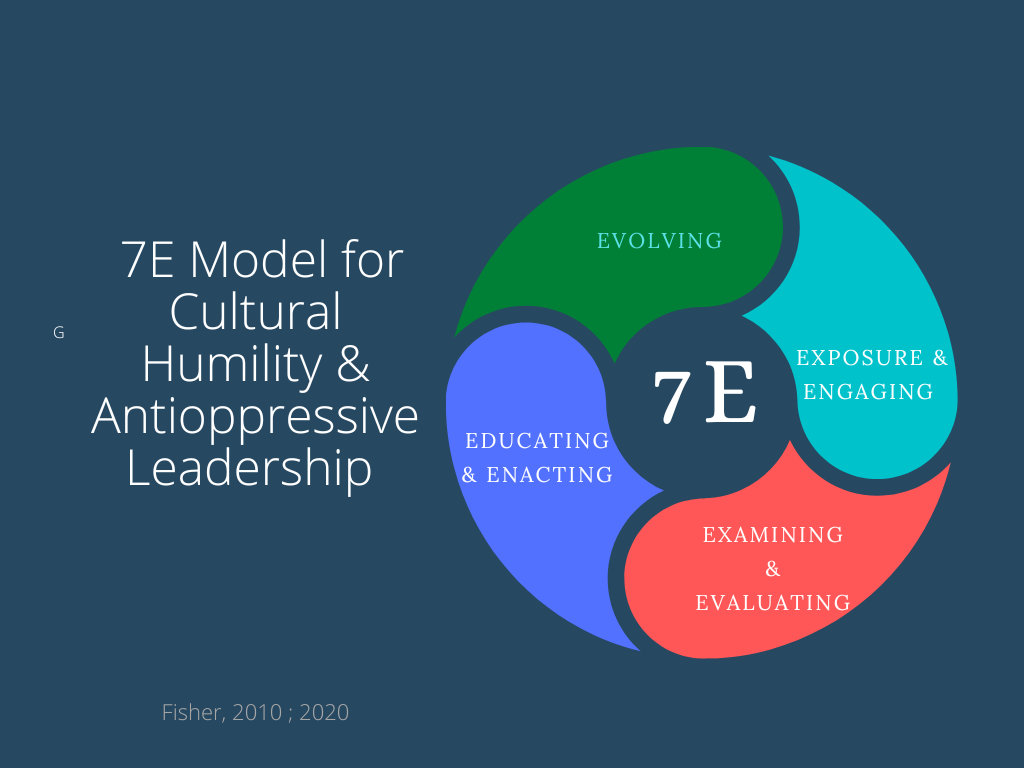
“Introduction & Structure
The 7E model for Cultural Humility and Antioppressive Action moves from intrapersonal work connected to the “lifelong learning and critical self-reflection” tenet of cultural humility and moves increasingly into interpersonal and institutional level action in keeping with the tenets of “challenging power imbalances” and “holding institutions accountable” (Tervalon & Murray-Garcia, 1998 p.118).
Step-based models can easily become cemented in individual minds and collective consciousness as linear, hierarchical, and static—a very western, “objective” manner of engaging information when, in truth, much of life and learning tends to be interconnected, dynamic, and cyclical (if any structurally reliable pattern exists at all). For that reason, the 7E model uses the word “experience” rather than “step” to describe states of awareness and action. Experiences sometimes happen in the order described, and at other times they happen concurrently or partially concurrently.
“Encounter” Experiences: Exposure & Engaging
Encounter experiences are any experiences (whether incidental or intentional) in which an individual has occasion to observe, consume, or participate in an activity that is foreign to their own intersectional identities and experiences. An easy way to identify such experiences is to consider what you are reading, watching, listening to, and/or attending.
Reflective Experiences: Examining & Evaluating
Reflective Experiences can happen before, during, or after Encounter Experiences and are characterized by examining thoughts, feelings, and actions in anticipation of, or in response to, engaging with new people, content, and/or experiences. Initially, “examination” is meant to be practiced as a non-judgmental self-observation, simply noticing changes in the three “b’s” “body” (ex: sweat, tears), “brain” (ex: judgments, defense mechanisms) and “behavior” (ex: yelling, leaving).
Interventive Experiences: Enacting & Educating
While Encounter and Reflective experiences primarily help students develop the “lifelong learning” and “critical self-reflection” tenets of cultural humility, interventive experiences move into the more actively antiracist tenets of challenging power imbalances and holding institutions accountable. Educating & enacting change means practicing microresistance in interpersonal relationships and macroresistance strategies when the systems and institutions of which we are a part are guilty of dominant-group supremacy in policies, procedures, or practices.
Maintenance Experience: Evolving
Any model must have a maintenance mechanism and any antiracist model must honor the requirement to evolve because systems will always continue to find ways to evade and pervert justice. Truly humble and anti-racist activists must be agile enough to take in new data, learn fresh terminology, and employ emergent strategies.”
Reflections
- What connections did you make to the material in these sections?
- Connections to other academic learning?
- Connections to your own experiences, thoughts, and/or emotions?
- Connections to current news and/or pop culture?
- What questions do you still have about the material in these sections? What feels fuzzy, or just out of your grasp?
Intersectionality: a framework for conceptualizing a person, or group of people, or a social problem as affected by a number of discriminations and disadvantages. It takes into account people’s overlapping identities and experiences in order to understand the complexity of prejudices they face (Oxford, 2017). See the term originator in her famous Ted Talk below.
General Approaches
Whenever possible this text aims to take a Non-Binary, Di-Unital, Both/And/Neither/Nor approach to content delivery and assessment. There is very rarely one right definition, theory, or approach to leadership or to DEI. Instead, the text tries to offer a variety of language, stories, and practices that will help each student with their own intersectional analysis and adoption of the ideas influencing them as leaders.
Reflections
- What connections did you make to the material in these sections?
- Connections to other academic learning?
- Connections to your own experiences, thoughts, and/or emotions?
- Connections to current news and/or pop culture?
- What questions do you still have about the material in these sections? What feels fuzzy, or just out of your grasp?
References
Archway Programs (2020, July). Archway forms DEI committee. Retrieved from
Center for Creative Leadership (2022, November). The core leadership skills you need in every role. Retrieved
from: https://www.ccl.org/articles/leading-effectively-articles/fundamental-4-core-leadership-skills-for-every-
career-stage/
Crenshaw, K. W. (1989). Demarginalizing the Intersection of race and sex: A Black feminist critique of antidis
crimination doctrine, feminist theory and antiracist politics. University of Chicago Legal Forum, 1989(1), 139-
167. http://chicagounbound.uchicago.edu/uclf/vol1989/iss1/8
Fisher, K. (2021). An experiential model for cultivating cultural humility and embodying antiracist action in and
outside the social work classroom. Advances in Social Work 21(2/3), 690-707. https://doi.org/10.18060/24184
Hart, D. G. I. (2016). Trouble I’ve seen: Changing the way the church views racism. Herald Press.
National Association of Social Work [NASW]. (2015). Standards and indicators for competence in social work
practice. NASW. https://www.socialworkers.org/LinkClick.aspx?fileticket=7dVckZAYUmk%3D&portalid=0
Sue, D. W., Rasheed, M. N., & Rasheed, J. M. (2016). Multicultural social work practice: A competency-based
approach to diversity and social justice (2nd ed.). Jossey-Bass.
Tervalon, M., & Murray-García, J. (1998). Cultural humility versus cultural competence: A critical distinction in
defining physician training outcomes in multicultural education. Journal of Health Care for the Poor and
Underserved, 9(2), 117-125. https://doi.org/10.1353/hpu.2010.0233